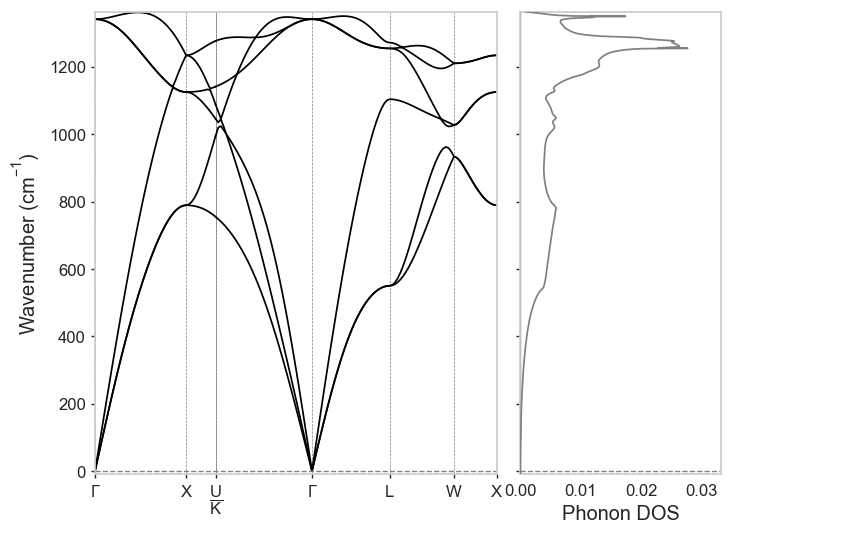Example 3: Phonon calculations with CASTEP and run3¶
In this example, we will go from a crystal structure to phonon dispersion and DOS plot using run3 and CASTEP. As with electronic dispersion, run3 uses the SeeK-path library to generate standardised band paths through reciprocal space to automatically compute a useful dispersion for all crystal types.
Phonon calculations follow a similar procedure to the spectral calculations in Example 2: run3 expects to find a folder containing .res files with lattice/atomic position data, and one .cell and one .param file specifying the CASTEP options. Standard run3 rules apply: if a <seed>.res.lock file is found, or if the .res file is listed in jobs.txt, the structure will be skipped. Such a folder can be found in examples/phonons/ which contain structures of Si, Li and C. The Jupyter notebook phonon_results.ipynb will also show you exactly how to plot and analyse the results of the phonon calculations with the API.
run3 will follow some simple rules to decide what kind of phonon calculation you want to run. First, it will check that task is set to phonon in the base param file. The workflow will then perform the following steps:
Relax the structure to the given
geom_force_tol(which often needs to be very low for phonon calculations ~0.001 eV/A). If a.checkfile containing a relaxation is found, then this step is skipped.From the structure/wavefunction found in the
.checkfile computed in step 1 (or otherwise), compute the dynamical matrix with the given supercell/q-point spacing with CASTEP.If
phonon_fine_kpoint_path_spacingwas specified in the base cell file (or a particular set of kpoints), then perform the dispersion calculation with CASTEP’s built-in Fourier interpolation.If
phonon_fine_kpoint_mp_grid_spacingwas specified in the base cell file, then perform a phonon DOS calculation with CASTEP’s Fourier interpolation.
The output files will be cached in such a way that the .phonon file from the DOS calculation will not be overwritten by the other steps, and vice versa.
The specific example cell and param files will perform all of the above workflow steps:
$ cat phonon.cell
kpoints_mp_spacing: 0.07
phonon_kpoints_mp_spacing: 0.1
phonon_fine_kpoints_path_spacing: 0.05
phonon_fine_kpoints_mp_spacing: 0.05
snap_to_symmetry
symmetry_tol: 0.01
symmetry_generate
%block species_pot
QC5
%endblock species_pot
$ cat phonon.param
task : phonon
phonon_method : finitedisplacement
phonon_fine_method : interpolate
cut_off_energy : 300.0 eV
write_bib : False
xc_functional : LDA
geom_force_tol : 0.05
finite_basis_corr : 0
write_checkpoint : none
The results can then be plotted with the dispersion script, if supplied with the -ph/--phonons flag, e.g.
$ dispersion -ph completed/C
